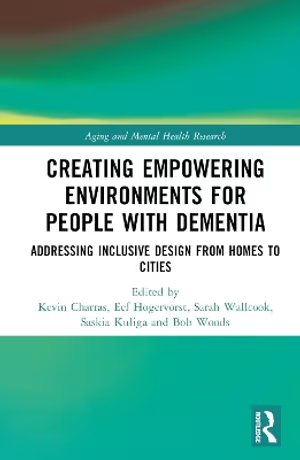A new open access book is a must for anyone interested in design with and for people with dementia. “Creating Empowering Environments for People with Dementia” is exactly what the book is about. It addresses inclusive design both inside and outside the home, including agricultural settings.
The book features the voices and opinions of people living with dementia. The chapters showcase individual homes, public spaces, landscapes and urban design. Care homes and special dementia facilities are also featured.
The focus is on person centred design that enables and empowers, and includes cultural differences in people’s needs. That means co-design.

A book for built environment practitioners and researchers in the fields of gerontology.
Chapter topics
Part 2 is titled “People with dementia are central to the design process”. It is about people with dementia being at the core of environmental design. A co-design approach to both home and neighbourhood design is essential in this context. People with dementia have a voice and know what they need.
Part 3 is about neighbourhoods. It includes chapters on public organisations, transport systems and spaces, and participatory health research. Toilets are a key feature for inclusive design, both newbuilds and refurbishments.
Part 4 has two chapters on hospital design, and Part 5 covers care home design. There is an interesting chapter on “care farms”. Not everyone with dementia lives in the city so some people respond well to an agricultural care setting.
The book is open access on ResearchGate and also from Taylor and Francis Group.
From the introduction
This edited volume addresses the environments that exacerbate, exclude, and stigmatise those living with dementia to explore designs and processes that can optimise well‑being and independence.

Featuring the voices and opinions of people with dementia, the chapters showcase individual homes, special dementia facilities, different forms of care homes, and public spaces, from landscape to urbanism, as examples of how to meet the needs and preferences of those living with dementia now.
This book demonstrates a range of research methods that can be used to inform and investigate good co‑design of dementia‑enabling environments. Furthermore, the book addresses cultural differences in people’s needs and illustrates past, ongoing, and novel initiatives worldwide.
Ultimately, this timely volume focuses on person‑centred design that enables empowerment, quality of life, health, and citizenship in people living with dementia. It will be of value to researchers, scholars, and postgraduate students studying gerontology, dementia specifically, and those involved with architecture and the built environment for societal benefit more broadly.
Dementia-friendly assessment tool

The Dementia Friendly Community Environmental Assessment Tool provides a relatively simple checklist. It takes in many of the regular aspects of accessibility overlaid with design thought for people with dementia. A good place to start your thinking.
The more recent online resource from Dementia Training Australia expands on the 2015 edition and goes into more detail. Sections can be downloaded separately. There are three parts in the handbook:
- 1 ‘Key Design Principles’ contains a description of key design principles.
- 2 ‘The Dementia Friendly Community – Environmental Assessment Tool introduces the tool and provides directions for its use.
- 3 ‘Using the Spreadsheet’ contains a guide to scoring and showing the results graphically.
This assessment tool is No. 5 in a set of 7 resources within the Environmental Design Resources Handbook.
There is also a free app to guide you through an assessment on the strengths and weaknesses of buildings for people with dementia. The website has more resources covering both community living and residential care.
